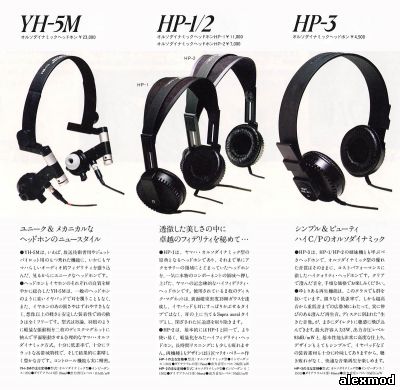| Alex | Дата: Вторник, 06.08.2019 | Сообщение # 1 |
 Автор сайта
Группа: Администраторы
Сообщений: 3035
Репутация: 120
Статус: Offline
| Итак, в мои руки (наконец-то) попала модель, выпуском которой Yamaha стартовали свою собственную линейку ортодинамики, которая с успехом производилась вплоть до конца 90х..
Модель, внешне известная любому советскому меломану, благодаря выпускавшемуся на территории СССР клону модели в лице ТДС-5(5м).
Оригинал Yamaha HP-1 увидел свет еще в 1975 году!

Немного истории о модели:
Цитата Yamaha HP-1 and the later, virtually identical YH-1 shared the same Mario Bellini headset design, revolutionary for its day; it really was
as comfortable as it looked. Many headphones manufactures have since
adopted a similar arch-and-strap arrangement. Mostly this works well. In
the HP/YH series there are, however, a couple of small mechanical problems:
1) the ball-joint earcup pivot connects to the headband via an unreinforced small-diameter plastic strut. If the headphones are dropped
and this strut breaks, the headphone is done for, because no one so far
has come up with a repair that holds, though successful repairs have
been done to the similar but more elaborate YH-1000. 2) that ball joint pivots in a small, loose-fitting metal socket inside the earcup and makes loud, annoying clicking and clunking sounds
as the headphones are settled on the listener's head. The sounds are
carried through the entire structure; it's a sensation not unlike
flicking a plastic ruler held clenched in the teeth. Not a problem if
the listener holds still, but disconcerting, especially at first.
Performing the damping mods described elsewhere usually solves this
problem.
HP-1 and YH-1 both use Yamaha's 55mm diameter isodynamic (aka orthodynamic)drivers. Effective diameter (ie, the diameter over which
the diaphragm is actually able to produce sound) is about 48mm. The less
expensive HP-2 and HP-3 (as well as the later YH-2 and YH-3) achieved their cost savings in part by using 46mm diameter drivers.
Driver impedance is 150 ohms. This is a function of both the length and thickness of the spiral aluminum track (these affect its DC
resistance) and its inductance (nearly negligible).
Diaphragm thickness is 12 microns of polyester, with the aluminum voice coil plated (or glued) 9mm thick on top of that. This compares to
the Stax SR-40 electret electrostatics' 6 microns and the first Stax Lambda's 2 microns; the later Yamaha YHD series had 38mm drivers with 6 micron diaphragms.
VariantsThere are certain HP-1s with a slightly different driver. These were sold in black, rather than silver, boxes and have anisotropic
magnets, which appear to be the normal ferrite discs used in most HP-1s but with thin, perforated iron or steel plates attached to the outer
surfaces of the driver, which very much resembles the later YH-100
driver but is a couple of dB less efficient. There was no model change
on the headphones themselves, just the appropriate change in the magnet
specification, and the sensitivity (efficiency) showed a 2dB gain (see
below-- also note that the service manual gives only the sensitivity of
the Anisotropic model). It is uncertain so far what, if any, sound
differences these drivers exhibit.
There is also an extant brochure showing a Yamaha HP-1A model (same specs and appearance as HP-1), but so far no one has seen an example.
General Description of the Sound
 
Example of a damping scheme
Without modification the YH-1 and HP-1 twins sound pleasant, with a more or less accurate tonal balance and a relaxed, mellow sound
signature, somewhat lacking in sparkle. The sound stage is small but
accurate with sufficient depth but limited width.
After possible modifications such as:
1) Adding bluetack or dynamat to the driver interior2) Sealing the driver to the baffle using bluetack or silicone sealant3) Adding extra damping materials (usually felt) to the driver itself and to the driver housing interior4) Adding a so-called reflex dot (a treble reflector applied to the back of the driver) if neededThe frequency response flattens and low frequency resonance hump is almost gone. This results in better perceived high frequencies,better pitch discrimination in the bass, and a better differentiation of bass from mid-bass. Sonic characteristics such as the smooth and non-fatiguing presentation remain intact. The transient response and perceived level of details across the frequency spectrum begin to approach electrostatic transducer levels. The sound stage is still
small, but even more accurate, and placement of instruments is precise.
Pricing & Other Data of Interest
 
HP-1 driver. Photo by Wualta
HP-1 was Yamaha's original top of the line Orthodynamic model. It was introduced in 1975 the Japanese market for 11,000 Yen. Then 1976 for about $200 in the US ($65 in 1977), 33 british pounds. It is visually and technically almost identical to the YH-1 model from ~1978, with carries same specifications but has no known Anisotropic variant.
SRP £42.95, and street price of £34.65 in 1979 UK market.
Technical specifications:
Impedance: 150 ohms
Frequency Response: 20-20,000Hz
Diaphragm: 12 micron polyester
Magnet: sintered ferrite or anisotropic ferrite, 55mm Diameter
Sensitivity: 94dB/mW (Anisotropic model: 96dB/mW)
Rated input: 3wMax input: 10w
Harmonic distortion: < 0.3% at 90dB SPL
Love the MUSIC, not equipment!
High-end portable now has a simple solution: aleXmod+RE272
|
| |
| |